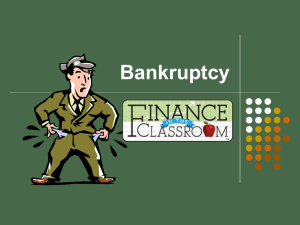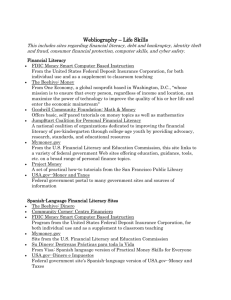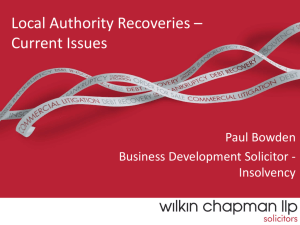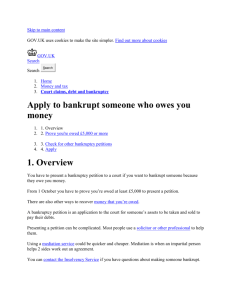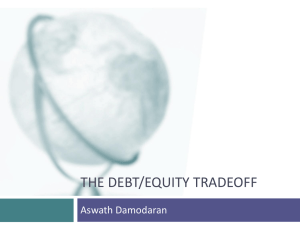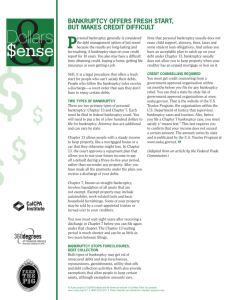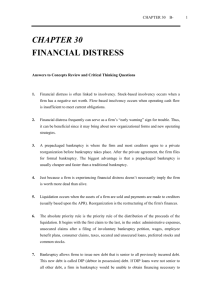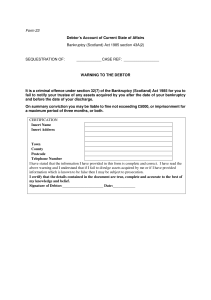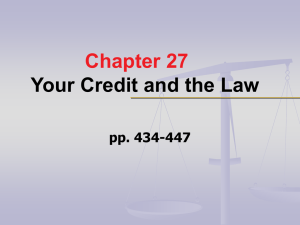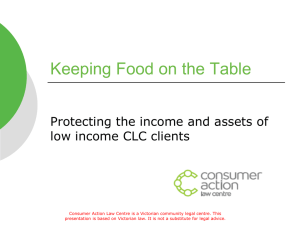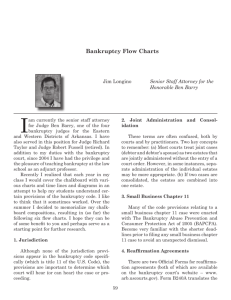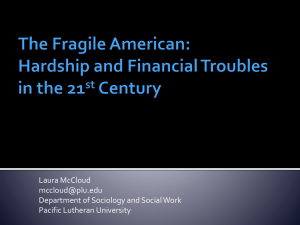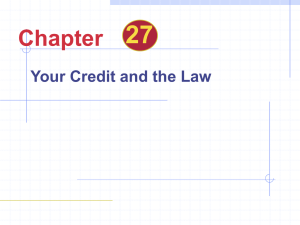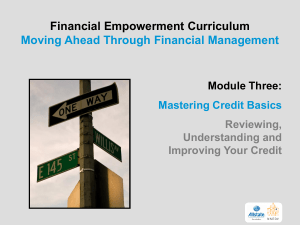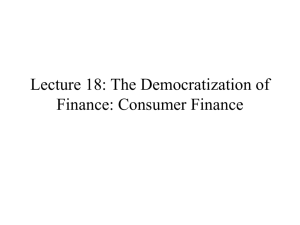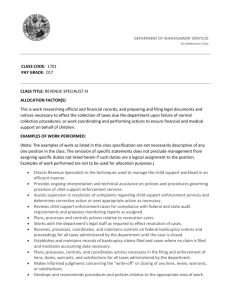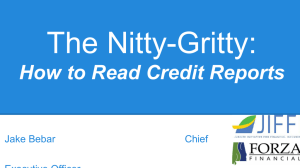PowerPoint Slides: Chapter 9
advertisement
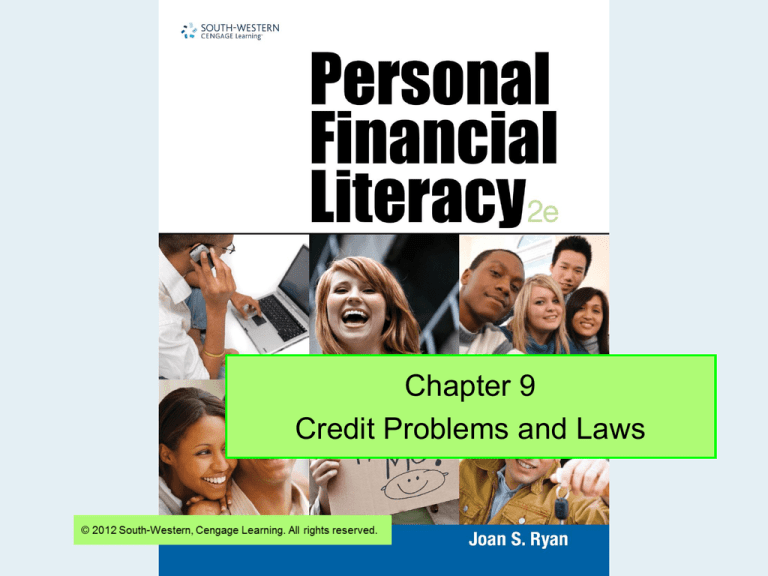
Chapter 9 Credit Problems and Laws How Can Consumers Protect against Errors and Fraud? • Disputing a charge is the process of informing a credit company of an error on your bill. o Document all steps of your dispute and send a letter to the credit company. • Credit card fraud is when someone uses your credit account to steal money or goods. o Notify creditor as soon as possible. 9-1 Resolving Credit Problems Slide 2 What Help Is Available to Consumers? Better Business Bureau Promotes responsible business practices in the marketplace to build trust between buyers and sellers Consumer Action Promotes consumer rights, publishes educational materials, and advocates for consumers in the media and before lawmakers Consumer Federation of America Works to advance pro-consumer policies on a variety of issues before state and federal legislatures, regulatory agencies, and the courts Consumers Union Provides advice about products and services in its publication Consumer Reports National Consumers League Sponsors the Fraud Center and addresses a wide range of issues in the marketplace Public Citizen Addresses issues such as the consumers’ right to seek redress; clean and safe energy sources; and strong health, safety, and environmental laws 9-1 Resolving Credit Problems Slide 3 What Help Is Available to Consumers? • Federal agencies o Federal Trade Commission (FTC) Bureau of Consumer Protection o U.S. government (www.usa.gov) o Consumer Action Handbook o Consumer Financial Protection Bureau o Federal Bureau of Investigation (FBI) • State agencies 9-1 Resolving Credit Problems Slide 4 What Problems Can Arise from Debt? • • • • • Credit delinquency Collection agencies Judgment Garnishment Repossession and foreclosure 9-1 Resolving Credit Problems Slide 5 Focus On . . . Telemarketing Fraud • To protect yourself, know the danger signs. o Examples: upfront fees, pressure to act immediately, no written documentation • Use a credit card in case you need to dispute the charge later. • Be cautious when dealing with unknown companies. • Use caller ID to avoid unwanted calls. 9-1 Resolving Credit Problems Slide 6 When Is Bankruptcy a Good Choice? • Bankruptcy is a legal procedure to relieve a person of excessive debt. • It can be voluntary or involuntary. • It gives debtors a fresh start. • It helps ensure fair treatment for creditors. • It should be a last resort because it damages your credit rating. 9-2 Bankruptcy Choices Slide 7 Avoiding Bankruptcy • Credit counseling o Sets up a budget and arranges a payment plan • Debt management o Creates a plan to pay off debt o Debtor must turn over checking account and give up credit cards • Debt consolidation o Process of getting one loan to pay off all debts 9-2 Bankruptcy Choices Slide 8 What Are the Types of Bankruptcy? • Chapter 7 o Also called straight or liquidation bankruptcy o Involves the forfeiture of assets in exchange for discharge of debts o Allows for exemptions, or property that a debtor does not have to forfeit, such as tools of trade 9-2 Bankruptcy Choices Slide 9 What Are the Types of Bankruptcy? • Chapter 11 o Also called a reorganization o It is the reorganization of debt as decided by the court. o Allows a business to remain viable • Chapter 13 o Also called individual debt adjustment o Involves a 3- to 5-year repayment plan for some of the debt 9-2 Bankruptcy Choices Slide 10 Building Communications Skills Persuasive Speaking • Open with attention-getting remarks. • Clearly state the position or action you want listeners to support. • Give supporting data or quotes to strengthen your position. • Prepare for negative reactions or questions. • Listen to campaign speeches and apply techniques to your speech. 9-2 Bankruptcy Choices Slide 11 Consumer Protection Laws • Fair Credit Reporting Act • Truth-in-Lending Act • Credit Card Act of 2009 • Fair Credit Billing Act • Equal Credit Opportunity Act • Fair Debt Collection Practices Act 9-3 Consumer Protection Laws Slide 12 Credit Card Company Error Correction Policy 1. Write description of the error. 2. Mail your letter as soon as possible. 3. Letter must be acknowledged in 30 days. Error must be corrected or explained in 90 days. 4. No collection letters will be sent or action taken while the charge is being disputed. 5. You are still responsible for other items on your bill. 6. You will not be charged a finance charge on disputed amount unless there is no error. 9-3 Consumer Protection Laws Slide 13 What Methods Can Be Used to Resolve Credit Disputes? • Alternative dispute resolution (ADR) uses a neutral third party. o Negotiation o Mediation o Arbitration • Filing a lawsuit o Small claims court o Class action lawsuit 9-3 Consumer Protection Laws Slide 14 How Can You Protect Against Credit Scams? • Credit repair scams occur when someone offers to “fix” your credit rating. • Identity theft occurs when someone uses your personal information to commit fraud or other crimes. 9-3 Consumer Protection Laws Slide 15 Success Skills Dealing With Difficult People • • • • Deal with the issues head-on. Meet the person in a private setting. Ask the person to explain his or her situation. Listen to what the person is saying and repeat concerns. • Ask for suggestions about how the problem can be resolved. • Talk to others affected by the behavior. 9-3 Consumer Protection Laws Slide 16


